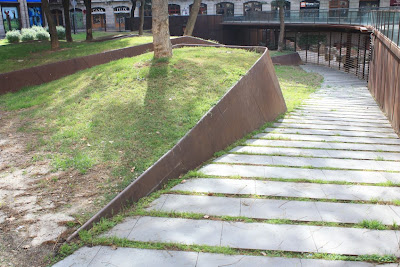Inside the Barcelona Gothic Quarter there are plenty of places where you can discover the ancient roman city of Barcino, the origin of the current Barcelona. The route I suggest to you begins in a quiet square called Villa de Madrid, located very near La Rambla and Plaça Catalunya.
This route will let you visit:
This route will let you visit:
- A Roman Necropolis
- An aqueduct arch
- La Casa de l'Ardiaca (Archdeacon’s House)
- Columns of the Temple of Augustus
- Wall and defense towers
Roman Necropolis
Barcino, by Joan Brossa
 In the Plaça Nova, in Barcelona Gothic Quarter, very near the wall of the former Roman city, seven giant letters form the visual poem by Joan Brossa. This poem is his own particular homage to the origins of Barcelona
In the Plaça Nova, in Barcelona Gothic Quarter, very near the wall of the former Roman city, seven giant letters form the visual poem by Joan Brossa. This poem is his own particular homage to the origins of BarcelonaAqueduct
Casa de l'Ardiaca
 On the other side of the aqueduct, stands the entrance to the Casa de l’Ardiaca, or Archdeacon’s House, which contains interesting archaeological remains. The Casa de l’Ardiaca was the residence of the ecclesiastical hierarchy from the 12th century onwards
On the other side of the aqueduct, stands the entrance to the Casa de l’Ardiaca, or Archdeacon’s House, which contains interesting archaeological remains. The Casa de l’Ardiaca was the residence of the ecclesiastical hierarchy from the 12th century onwardsColumns of the Temple of Augustus
 The columns of the Temple of Augustus, which are more than 2,000 years old, is one of the city’s best-kept secrets in a building on Carrer Paradís. Inside a small medieval courtyard, the four columns from the Temple of Augustus have survived despite the passing of the centuries
The columns of the Temple of Augustus, which are more than 2,000 years old, is one of the city’s best-kept secrets in a building on Carrer Paradís. Inside a small medieval courtyard, the four columns from the Temple of Augustus have survived despite the passing of the centuriesCarrer del Bisbe (Bisbe Street)
 You can discover the route of the Decumanus Maximus of the Roman city walking along el Carrer del Bisbe, one of the most interesant streets in the Barcelona Gothic Quarter
You can discover the route of the Decumanus Maximus of the Roman city walking along el Carrer del Bisbe, one of the most interesant streets in the Barcelona Gothic QuarterCarrer de la Llibreteria (Llibreteria Street)
 You can discover the route of the Cardo Maximus of the Roman city walking along el Carrer de la Llibreteria
You can discover the route of the Cardo Maximus of the Roman city walking along el Carrer de la LlibreteriaPlaça Sant Jaume (Sant Jaume Square)
 The Plaça Sant Jaume is located at the place where the main streets of Roman Barcino converged: the Cardus and the Decumanus. This place was the Roman forum, the centre of the Roman city where the Temple of Augustus once stood
The Plaça Sant Jaume is located at the place where the main streets of Roman Barcino converged: the Cardus and the Decumanus. This place was the Roman forum, the centre of the Roman city where the Temple of Augustus once stoodWalls and defence towers of the Roman City of Barcino
This picture shows the location of the sections of the Barcelona Roman wall which can be still seen
The royal chapel of Santa Àgata was built in the 14th century, as part of the Palau Reial. It stands elegant on top of the Roman wall, which provides its foundations. If you take a closer look at the Roman wall, you will see that the wall was constructed with materials obtained from other buildings

One of the defense towers of the Barcelona Roman City in Sots-Tinent Navarro Street


One of the defense towers of the Barcelona Roman City in Sots-Tinent Navarro Street

A house built inside one of the section of the Barcelona roman wall in Sots-Tinent Navarro Street
In the old city of Barcelona you can also visit other beautiful places:
- Cathedral of Barcelona
- Church of Santa Maria del Mar
- Plaça del Pi and Santa Maria del Pi
- Plaça del Rei
- Sant Felip Neri Square and Church
- Plaça de Sant Just and Sant Just i Pastor church
- Plaça Reial
- Santa Anna Church
- El Portal de L'Angel
- El Raval
- Call Jueu (Jewish Quarter)
- Born-La Ribera district
- Sant Pere de les Puelles church
- Carrer Petritxol
Next, some useful information about these places:
Roman Necropolis
- Metro L1 and L3, stop Catalunya.
- Bus 14, 59 and 91.
- FGC, stop Catalunya.
- Barcelona Bus Turístic, stop Pl. Catalunya.
Casa de l'Ardiaca
- How to get there:
- Metro L4, stop Jaume I.
- Bus 17, 19, 40 and 45.
- Barcelona Bus Turístic, stop Barri Gòtic.
- From Setember 1st to July 1st: Monday to Friday, from 9am to 8.45pm. Saturday, from 9am to 1pm.
- From July 2nd to August 31st: Monday to Friday, from 9am to 7.30pm.
Columns of the Temple of Augustus
- How to get there:
- Metro L4, stop Jaume I.
- Bus 17, 19, 40 and 45.
- Barcelona Bus Turístic, stop Barri Gòtic.
- From October to May, from 10am to 2pm & 4pm to 8pm.
- From June to September, from 10am to 8pm.
Finally, clicking on the next link you will find links to other beautiful places in Barcelona and other interesting places in the Barcelona Gothic Quarter.






No hay comentarios:
Publicar un comentario